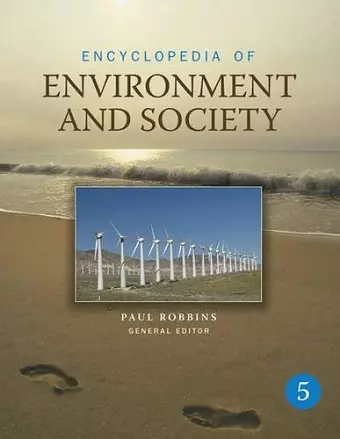Encyclopedia of Environment and Society
FIVE-VOLUME SET
Format:Set / collection
Publisher:SAGE Publications Inc
Published:28th Aug '07
Currently unavailable, our supplier has not provided us a restock date

"As befits the topic, this beautifully packaged, wonderfully illustrated, interdisciplinary resource has more than 1200 entries written by specialists. A helpful reader′s guide groups topics like agriculture, conservation and ecology, movements and regulations, politics, pollution, and society. A resource guide, chronology, glossary, and list of the UN′s economic indicators complete the set."
—Library Journal
"…this important work gives a well-focused snapshot of environmentalism in the early 21st Century, and it will remain valuable into the future both for its content and as a yardstick to measure progress toward sustainability and conservation. Summing Up: Recommended. Undergraduates and general readers."
—CHOICE
Booklist Editors′ Choice 2008
"This superb interdisciplinary work should find a place on the shelves of every public and academic library that has the least bit of interest in environment issues—which should mean just about all." —Booklist (Starred Review)
The Encyclopedia of Environment and Society brings together multiplying issues, concepts, theories, examples, problems, and policies, with the goal of clearly explicating an emerging way of thinking about people and nature. With more than 1,200 entries written by experts from incredibly diverse fields, this innovative resource is a first step toward diving into the deep pool of emerging knowledge. The five volumes of this Encyclopedia represent more than a catalogue of terms. Rather, they capture the spirit of the moment, a fascinating time when global warming and genetic engineering represent only two of the most obvious examples of socio-environmental issues.
Key Features
- Examines many new ideas about how the world works, what creates the daunting problems of our time, and how such issues...
“This superb interdisciplinary work should find a place on the shelves of every public and academic library that has the least bit of interest in environment issues—which should mean just about all.”
—Booklist (Starred Review) -- Booklist * Booklist *
"...As befits the topic, this beautifully packages, wonderfully illustrated, interdisciplinary resource has more than 1,200 entries written by specialists. A helpful reader′s guide groups topics like agriculture, conservation and ecology, movements and regulations, politics, pollution, and society. A resource guide, chronology, glossary, and list of the UN′s economic indicators complete the set." -- LIBRARY JOURNAL
“Nearly 300 scholars have contributed to this survey of socio-environmental issues. The consistent aim is to emphasize not just the interrelationships between the Earth’s natural environments and human society, but the inseparability of the two. This excellent guide will serve high school, public and academic libraries.”—Lawrence Looks at Books, Gale Reference Reviews -- lawrence reviews * lawrence looks at books *
“The editor describes this work as sitting astride the imagined boundary between society and environment, reflecting new knowledge gained through understanding the ‘intense entanglement’ of human and nonhuman spheres, and transcending old dichotomies of ‘green’ and ‘brown’ approaches to legislation, economics, and societal challenges. The 1,200 entries vary in length from one column to several pages. Current, representative biographies, including appropriate Web-based resources, compensate for the entries’ brevity. Hundreds of entries for geographic and topographic features, nation-states, and political entries appear along with the seemingly random terms (e.g., democracy, expertise, fodder, humidity, livelihood, obesity, pragmatism), each of which is significant in socioenvironmental discourse.
The comprehensive index includes the names of some 1,000 individuals, agencies, organizations, and seminal book titles, plus 37 feature films noted for representations of nature. Cross-referencing to related entries is generous. A ‘Reader’s Guide’ groups entry titles by broad headings (‘Geography,’ ‘History,’ ‘Movements and Regulations,’ and more), providing helpful context. Inclusion of the complete set’s index is curious, as is the repetition of 19 colored maps at the beginning of each volume. Providing more content and depth would have been preferable to these duplications. This important work gives a well-focused snapshot of environmentalism in the early 21st Century, and it will remain valuable into the future both for its content and as a yardstick to measure progress toward sustainability and conservation. Summing Up: Recommended. Undergraduates and general readers.”
—CHOICE
ISBN: 9781412927611
Dimensions: unknown
Weight: unknown
2736 pages